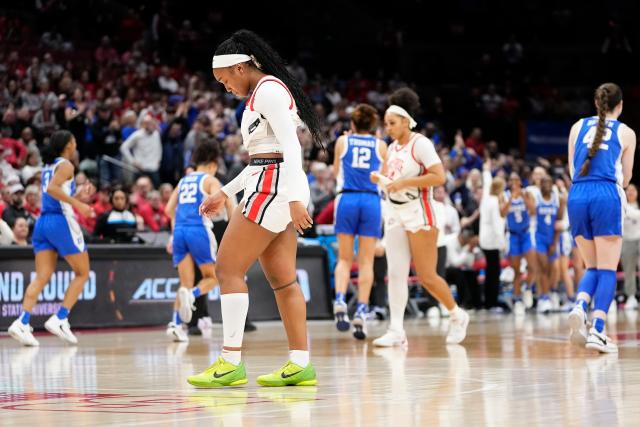“Our performance is sufficient”: Ohio State’s four main strategies before the NCAA Tournament
The NCAA Tournament is one of the most high-stakes, unpredictable events in college basketball. Every year, teams battle it out for a chance to etch their names into the annals of college basketball history. As one of the perennial powerhouses in the Big Ten, Ohio State has developed a unique approach to preparing for the tournament. While much of the focus in the lead-up to March Madness revolves around players and individual performances, the coaching staff at Ohio State has refined four main strategies to ensure their team enters the tournament ready to compete at the highest level.
These strategies are centered around maximizing player performance, ensuring mental preparedness, enhancing tactical execution, and promoting team cohesion. Together, these strategies form the foundation upon which Ohio State builds its NCAA Tournament campaigns.
1. Physical and Mental Conditioning: Ensuring Peak Performance
The first and most crucial strategy for Ohio State heading into the NCAA Tournament is ensuring that the team is physically and mentally conditioned to handle the grueling demands of the tournament.
Physical Conditioning
While college basketball teams typically maintain a high level of physical fitness throughout the season, the weeks leading up to the NCAA Tournament require extra focus on conditioning. The intensity of the tournament schedule, with multiple games in a short span, demands that players be in peak physical form. Ohio State’s strength and conditioning staff plays an integral role in this preparation.
- Focus on Endurance and Recovery: The Buckeyes emphasize endurance, ensuring that players can maintain a high level of energy even in the late stages of games. This is crucial, especially in the tournament, where games often stretch into overtime or require sustained effort over several days.
- Speed and Agility: Ohio State also places an emphasis on agility and speed. With the style of play shifting to faster, transition-based basketball in the tournament, players need to be nimble, able to move quickly on both offense and defense. Drills and exercises are designed to improve reaction times and fluidity of movement on the court.
- Injury Prevention: The team is also focused on minimizing the risk of injury. Training sessions, particularly in the days leading up to the tournament, involve a mix of high-intensity workouts and recovery techniques, including physical therapy, massage, and stretching routines. By reducing wear and tear on players’ bodies, the team hopes to avoid any significant injuries that could derail their tournament run.
Mental Conditioning
While physical readiness is crucial, Ohio State recognizes the importance of mental toughness in the NCAA Tournament. Players will face immense pressure, whether it’s the expectation of performing in front of a national audience or the stakes of win-or-go-home games. In response, Ohio State works with sports psychologists to ensure their players are mentally prepared for the challenges ahead.
- Stress Management: Players are taught techniques to manage stress and maintain focus during high-pressure situations. Techniques such as mindfulness, deep breathing, and visualization are integrated into the team’s routine to help athletes stay calm during intense moments.
- Confidence Building: The coaching staff fosters a sense of belief within the team, making sure that each player feels capable of stepping up when needed. Confidence-building exercises, coupled with motivational talks, help to ensure that players trust their preparation and abilities.
- Focus on the Team: Coach Chris Holtmann emphasizes the importance of a collective mentality. The team’s focus is on the process rather than the outcome, which helps reduce individual pressure. By emphasizing teamwork over individual performance, players are able to thrive in a supportive environment, which is vital in high-stakes tournament play.
2. Tactical Flexibility: Adjusting to Different Opponents
The NCAA Tournament features a diverse array of teams, each with its own unique style of play. In order to succeed, Ohio State must be able to adjust its strategies based on the strengths and weaknesses of its opponents. This requires a level of tactical flexibility that ensures the team is prepared for anything that comes its way.
Defensive Schemes
Ohio State has consistently been known for its tough, hard-nosed defense, and this will be a major focal point in the tournament. While the team typically plays a man-to-man defense, Coach Holtmann is known for being adaptable, switching to a zone defense when necessary to throw off an opponent’s rhythm.
- Key Matchups: A major part of Ohio State’s defensive strategy involves scouting opponents and preparing for specific player matchups. For example, if the opposing team has a dominant scorer or a quick guard, Ohio State’s defensive game plan will shift to neutralize that individual threat.
- Defensive Pressure: Ohio State has been successful in the past with full-court press and half-court trapping strategies. Depending on the opponent, the Buckeyes might apply pressure early in the game to disrupt the opposing team’s offensive flow. This can lead to turnovers, which are critical in a tournament setting where every possession matters.
- Switching Defenses: To keep opponents off balance, Ohio State often employs different defensive schemes, such as switching between man-to-man and zone defenses. The ability to seamlessly transition between these two styles of defense allows the team to adapt quickly to changing situations on the floor.
Offensive Adjustments
While Ohio State’s defense tends to be the most consistent aspect of its strategy, the team also has a dynamic offensive approach that can be adjusted depending on the opponent’s strengths and weaknesses.
- Spacing and Ball Movement: The Buckeyes prioritize good ball movement to create open shot opportunities. Whether it’s working through a pick-and-roll offense or spacing the floor for three-point shooters, Ohio State aims to keep the defense on its toes with a fluid, team-oriented offense.
- Exploiting Weaknesses: If Ohio State faces a team with a weak interior defense, the strategy might focus on pounding the ball inside and utilizing the post players. On the other hand, if an opponent struggles defensively against the three-pointer, Ohio State might prioritize getting the ball to its shooters on the perimeter.
- Flexibility in Pace: Ohio State’s offense is also flexible in terms of tempo. Against a team that excels in fast breaks, the Buckeyes may focus on slowing the game down and controlling the pace. Conversely, against slower teams, Ohio State might opt for a faster, more aggressive offensive game plan to increase the tempo.
3. Focus on Individual Player Development: Maximizing Talent
While Ohio State is known for its team-oriented approach, the development of individual players plays a pivotal role in the team’s overall success. In the NCAA Tournament, individual performances can often be the difference between advancing or being eliminated, so Ohio State ensures that its key players are prepared to shine when the spotlight is brightest.
Star Players Stepping Up
Ohio State relies on a few key players to lead the team through the tournament. These players are often tasked with carrying the team in clutch moments. For instance, if a star player like a top scorer or a seasoned point guard is on the roster, Ohio State will ensure that they are in optimal form both physically and mentally.
- Offensive and Defensive Roles: Players like these are expected to contribute on both ends of the floor. Offensively, they are relied upon to score efficiently, but defensively, they are tasked with guarding the opponent’s best players. This dual role requires that star players stay in top physical condition and develop strong basketball IQs.
- Leadership and Communication: Beyond their skills on the court, star players are expected to be vocal leaders. Ohio State’s coaching staff encourages these individuals to communicate effectively, both to rally their teammates and to provide guidance during key moments in games.
Development of Role Players
While star players are essential, Ohio State also places significant emphasis on developing its role players. These athletes are expected to contribute in more specialized ways—whether it’s as a three-point shooter, a rebounder, or a defender. The development of role players ensures that the team has the depth needed to succeed in a tournament setting.
- Maximizing Potential: Players who may not be the primary focus of the offense are still given the tools to contribute. For example, a bench player known for his defensive prowess may be asked to shut down an opposing team’s key scorer in crucial moments. This kind of preparation ensures that all players are ready to step up when needed.
- Game-time Adjustments: Role players are often tasked with making in-game adjustments based on the flow of the game. Ohio State’s coaches train them to recognize situations where they can be most effective, whether it’s making an extra pass, grabbing a key rebound, or defending without fouling.
4. Team Cohesion: Building Unity for Success
Perhaps the most important strategy Ohio State employs is building a cohesive, unified team. In the NCAA Tournament, a team’s success is often determined by how well it can come together under pressure. Ohio State’s coaches and players recognize that tournament success relies heavily on teamwork and communication.
Building Chemistry
Ohio State places a strong emphasis on team bonding, both on and off the court. The coaching staff organizes team-building exercises, which are designed to foster trust and camaraderie among the players. Whether it’s team dinners, off-site retreats, or informal gatherings, the idea is to build relationships that extend beyond basketball.
- Communication on the Court: Strong communication is vital during the tournament, as teams face constant challenges that require quick decision-making. Ohio State’s coaches encourage constant verbal and non-verbal communication during practices and games to ensure players stay on the same page.
- Support for Each Other: The coaches stress the importance of players supporting each other, regardless of who is on the court. This positive and supportive environment allows players to remain calm during high-pressure moments, knowing they have the backing of their teammates.
Ohio State’s four main strategies—physical and mental conditioning, tactical flexibility, individual player development, and team cohesion—are designed to ensure that the Buckeyes enter the NCAA Tournament fully prepared to face the challenges of March Madness. These strategies are not just about basketball; they are about developing the mindset and the teamwork necessary for success at the highest level.
While there are no guarantees in the NCAA Tournament, Ohio State’s commitment to preparation, adaptability, and unity gives them a strong foundation to compete against the best teams in the country. With these strategies in place, the Buckeyes hope to make a deep run in the tournament and continue their tradition of excellence in college basketball.



